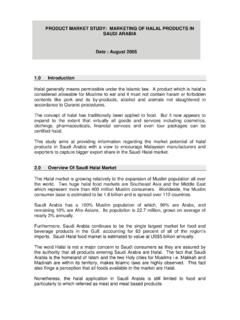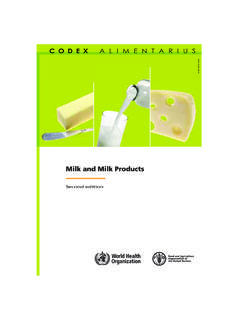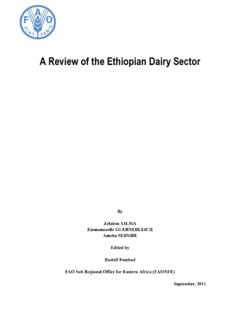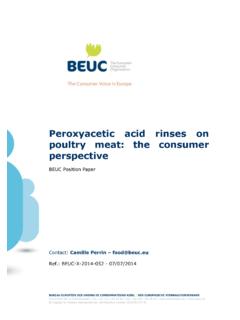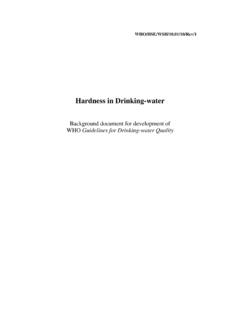Transcription of An overview of changes in the characteristics ...
1 An overview of changes in the characteristics , functionalityand nutritional value of skim milk powder (SMP) 10, 2001 SummarySkim milk powder (SMP) has low moisture and fat contents and, when stored in dry,cool conditions, has a shelf life in excess of two years. Specifically, when stored at 15 Cand a relative humidity of 75%, skim milk powder has a minimum shelf life of two years,an average shelf life of three years and a maximum shelf life of four powders are hygroscopic: they tend to attract water readily from humidatmospheres. When moisture levels are excessive, milk powders may become sticky,caked or lumpy, and exhibit reduced flowability and solubility. These changes affect theease of use of the product, requiring grinding for example and may affect the flavor, butdo not represent a health or safety problem.
2 If the powder s moisture content exceeds15%, it then becomes susceptible to microbiological growth and should not be milk powder should have a mild flavor and aroma. After extended storage, somemilk powder may develop slight off-flavors. These may be noticed in rehydrated or recombined milk products. However, milk powders for use as ingredients inmanufactured foods and dry blends generally do not need to meet as high standards ofpalatability and skim milk products stored in optimal conditions in proper packaging showessentially no change in color, even during two years of storage at 35 C. In commercialsituations, most dried milk products are susceptible to reactions that can result in smallchanges in the physical properties of the product, its palatability and nutritive changes , however, do not significantly impact the nutritional benefits of milkpowders.
3 Vitamin and protein quality losses during storage of milk powders, whenstored in good conditions, are milk powder should be stored in sanitary, cool, dry conditions, away from strongodors. Milk powders from bags that have been opened or damaged during transit orstorage, or that appear spoiled; to have been contaminated or tampered with in anyfashion should never be used. 1 Prepared by the Dairy Export Council, with the collaboration of Dr. N. Farkye, CaliforniaPolytechnic San Luis Obispo, Dr. K. Smith, Wisconsin Center for Dairy Research, and F. Tracy Schonrock,SchonrockConsulting. October of storage on chemical and physical properties of skim milkpowders Which flavor changes can be expected?The flavor and odor of milk powder should be sweet and clean, entirely free from rancidor other objectionable odors.
4 Off-flavors developing in dried milk products duringstorage may be due to many different compositional, processing or other variables. Incommercial situations, the presence of other foods or packaging materials duringtransport may also have an effect on the flavor of dried milk products. It is important tostore milk powder away from other ingredients with a strong odor such as garlic, onions,spices and flavorings, away from other materials with strong odors such as gasoline,fuel oil, fertilizer, or chemicals, and away from moldy occurrence of off-flavors may also be an indication of spoilage, microbial growth, orcontamination. Bags of milk powders should be stored in a dry, clean area. Contactwith spoiled foods, wet cardboard, wood or any other material that may be moldy or hasthe potential to support mold growth should be avoided.
5 A milk powder that hasdeveloped a strong, objectionable odor should not be or cardboard flavors have also been reported in different types of dried dairyingredients, including milk powders and maybe due to a large number of factors otherthan storage. Off-flavors due to the Maillard reaction are generally characterized as caramelized or toasted. At high storage temperatures, these types of flavors havebeen described in dried milk products. A slight caramelized taste is objectionable inproducts such as yogurts, ice cream and similar products. It is not a problem in otherfood applications such as in baked goods and some dry blends. Is solubility affected by extended storage?Extended storage of dried milk products may result in decreased solubility of insolubility is generally attributed to the Maillard reaction, which involves reducingsugars and proteins.
6 Storage studies of dried milk products have shown that theproducts stored in a variety of conditions could exhibit slight changes of solubility. Thechanges are not commercially important, yet it remains preferable to store milk powdersat temperatures well below 40 C for a maximum retention of solubility characteristicsover a long period of term solubility is also used to describe the dispersing characteristics of milkpowders when reconstituted with water or other fluids. Tests to determine the solubility of milk powders depend upon a number of factors such as the amount ofdissolved minerals, hardness , in the water used, speed and duration of stirring andtemperature, and other factors. The use of mechanical agitation and mild heat insanitary conditions may be required to facilitate wetting and dispersion of some milkpowders.
7 For uses where the powder is blended with other dry ingredients as, forexample, in baked goods, the degree of solubility of milk powder is not very critical. What is the impact of browning on functionality of milk powders?A powder that has developed extensive browning or appears to have deterioratedshould not be used. Slight browning may be associated with flavor changes , makingthe powder less desirable in applications such as yogurt, ice cream and other dairyproducts. These changes , however, are not noticeable in bakery applications. Somestudies have shown, in fact, that volume of baked goods can increase with the length ofstorage and degree of browning of dried milk ingredients. Typically, the level of proteindenaturation achieving during the processing of milk powders is a more significantindicator of performance for industrial bakers than small changes occurring duringstorage.
8 What is the impact of storage on the powder s acidity? ( pH level)In some studies, the pH of milk powders stored at room temperature was shown todecrease. The pH change can also be attributed to the bonding of amino groups bylactose in the Maillard reaction. changes in pH do not appear to be significant for a milkpowder user at the commercial milk powder that has deteriorated extensively as a result of poor storage conditions,and that appears to have an unpleasant, acidic taste, should not be used. What is the impact of storage of flow properties?Development of stickiness, caking, and lumpiness can take place during storage ofdried milk ingredients. Skim milk powder is hygroscopic (attracts moisture) because ofits high lactose content. If exposed to the atmosphere it can absorb sufficient moistureto induce caking or the development of lumps, resulting in a powder that flows poorly ornot at all.
9 Proper storage conditions and good packaging can reduce stickiness, caking,and lumpy problems. What can be done if the product has caked ?SMP that has been exposed to excessive heat and moisture may develop stickinessand cake, and these changes do have commercial significance. Caked dried milkpowder can be ground after which it will remain free flowing unless exposed to highhumidity. The powder should be allowed additional time to dissolve, and may requireadditional stirring. In all cases, when recombining milk, clean potable water should beused and the appropriate heat treatment applied to the product after the moisture uptake is such that off-flavors have developed, the product or itspackaging appears moldy or seem to have deteriorated, the milk powder should bediscarded.
10 Milk powder from any bag that has been opened prior to use or appears tohave been tampered with should never be used. How does browning develop in milk powders?Ordinarily browning is not a major type of deterioration in SMP during storage. Non-enzymatic browning can take place in SMP as in many casein-lactose systems. Non-enzymatic browning via the Maillard reaction is one mode of deterioration in milkpowders, which may limit shelf life. Milk powders contain relatively high concentrationsof lactose and protein high in lysine (an amino acid) content. In the presence ofmoisture, these components readily participate in the Maillard reaction. This interactionmay result in changes in protein quality that is accompanied or followed by undesirablecolor changes .



